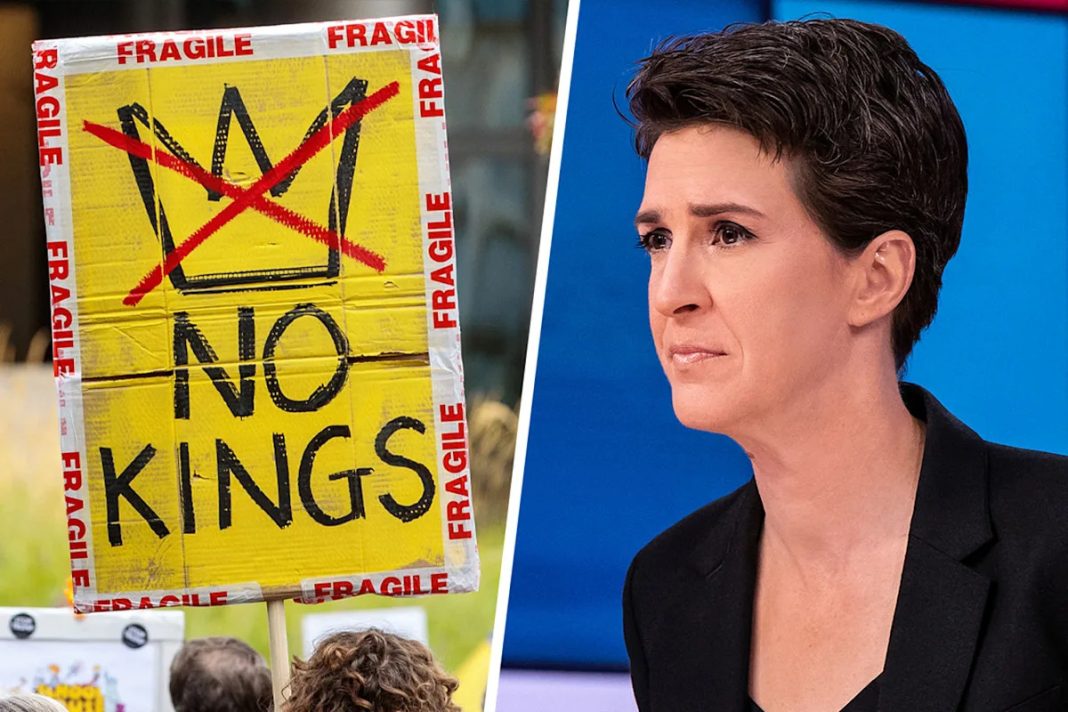This is an adapted excerpt from the Oct. 20 episode of “The Rachel Maddow Show.”
On Saturday, nearly seven million people turned out nationwide for the “No Kings” rallies, making it one of the largest single-day protests ever in U.S. history.
Hundreds of organizers banded together to put on the protests, including the group Indivisible, which may sound familiar if you are a frequent viewer of “The Rachel Maddow Show.”
For years, we have been talking to folks from Indivisible, and you might have noticed that every time we talk to them — going back to the very beginning — they tend to emphasize a key principle when it comes to protest: think local.
For example, for these “No Kings” rallies, Indivisible told protesters that if you have to travel more than an hour to find an event, then don’t. Instead, you should be organizing your own protest in your own community.
That is not generic protest advice. That is very specific to this movement — and it has specific consequences, which we saw in action this weekend. On Saturday, there wasn’t just one giant protest in one central place, but hundreds of different protests, in big cities and small towns and every nook and cranny across this country.
If that dynamic feels different to you, that is because it is. New research from the Kennedy School at Harvard University, titled “The Resistance Reaches into Trump Country,” found that during Donald Trump’s second term, the share of counties “hosting at least one anti-Trump protest has risen markedly … surpassing the historic spikes observed during his first term.”
The data also shows that in comparison with the president’s first term, there are more protests in what we traditionally think of as red, pro-Trump areas of the country. Researchers found that “the median protest county in the U.S. sent more votes to Trump in 2024 than Harris.”
One of the academics behind that new research from the Kennedy School is Erica Chenoweth, who is perhaps most famous for their research into something called the 3.5% rule.
Chenoweth has studied hundreds of movements from around the world over the past century to identify what makes for a successful popular campaign against an authoritarian government.
Chenoweth found that successful movements tend to share numerous things in common. No. 1: nonviolence. Nonviolent protest movements were twice as likely to prevail as violent ones.
Successful movements reach into uncharted territories and appeal to new constituencies, which is what makes the spread of the “No Kings” movement into Trump counties so important. Successful movements establish and maintain momentum, pushing people in positions of influence to change their behavior and priorities.
While Chenoweth’s research determined that all those factors are necessary for success, they are still not enough.
If you want to guarantee success against authoritarianism, there is one more thing you must do: You must grow until at least 3.5% of the population is out in the streets protesting.
That is the 3.5% rule. Along with all the other criteria, if you manage to get that 3.5% of the country out in the streets with you, the historical data suggests your movement will win.
In the U.S., 3.5% of the population amounts to almost 12 million people. Yes, that is a lot of people, but consider the trend line here: For the big “Hands Off” protests in April, Indivisible estimated the turnout at three million people. For the first “No Kings” rally in June, turnout was estimated at around five million. And on Saturday, Indivisible estimates nearly seven million people came out. Considering that growth, in just a few months, does 12 million really seem so far away?
This article was originally published on MSNBC.com

